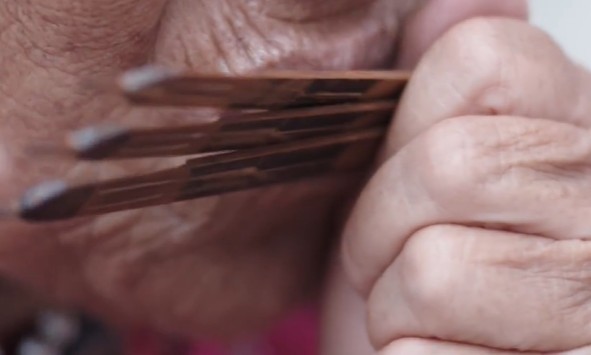The craftsmanship of bamboo spring
174 views · Organized by 薄暮 on 2022-02-09
Bamboo springs are made from hard, dry bamboo chips. Depending on the number of reeds, there are single-piece bamboo reeds and multi-piece bamboo reeds. Due to different playing methods, there are bamboo reeds that are plucked with fingers and stretched with silk threads. According to the different shapes and head styles, they are divided into convex head shapes. , mesh needle shape, flat head shape, cone shape and tubular shape, etc.

Convex-shaped bamboo spring
Popular among Naxi, Nu, Lisu, Dulong, Yi and other ethnic groups. A common set of three tablets. The shape is small, about 6 cm to 10 cm long, 0.6 cm wide, and the protruding head is 1 cm long as the bombing part. The sound is clear and bright, and the volume is low. Drilling the shank ends of several single-piece bamboo springs and threading ropes becomes a group of multi-piece bamboo springs. Each group consists of 2 to 5 tablets. The pitch of the bamboo reed depends on the length, width and thickness of the reed. If beeswax is added to the head or middle of the reed, the same reed can also produce a lower tone.

Mesh needle-shaped (also known as sword-shaped) bamboo spring
Popular in Yi, Lahu, Wa, Brown and other ethnic groups. Different sizes, the head angle is about 60 degrees, it is shaped like a mesh needle, and it is like a sword. The large bamboo springs of the Yi people are about 13 cm long and 1.5 cm wide, and the small ones are about 6 cm long and 1 cm wide. The production is made of bamboo pieces, thin bamboo pieces are cut with a sharp knife, and a reed tongue is hollowed out on three sides in the middle. The length of the reed tongue is 3/5 of the reed, and the width is 1/3. The beginning of the film is sharpened in the shape of a mesh needle or sword, and the end of the film is cut off as a spring handle. The Brown, Jingpo, Wa, Hani and other ethnic groups mostly use one or two bamboo reeds, which are larger in size. The Brown bamboo reed is 21.5 cm long and has a deep and deep voice. The Lahu and Yi people like to use two, three, four or five-piece bamboo springs.Flat head bamboo spring
Popular among Yi, Tibetan, Qiang, Gaoshan, Lisu, Nu, Hani and other ethnic groups. The head is thicker with bamboo joints. Larger in size, mostly single spring. The puller that pulls the pronunciation with a thread also belongs to this category. The Hani bamboo reed in Xishuangbanna is 17 cm long, 1 cm wide and 7.5 cm long.Conical bamboo spring
Relatively rare, popular in the Ningxia Hui Autonomous Region. 15 cm long, 1.7 cm wide head, 12.2 cm long tongue, big head and small tail, tapered. There are wavy notches on both sides, and the spring surface is decorated with red, green and blue colors.Tubular Bamboo Spring
Popular in the Gaoshan area of Taiwan, there are two types of tubular and semi-tubular. Two or more bamboo springs are tied on the top. Both ends of the bamboo spring are tied. The method of playing is the same as that of La Mer.Involving musical instruments
Bamboo spring (pinyin: zhú huáng) is also known as ringing bamboo, blowing bamboo, playing bamboo, mouth contempt, mouth spring, harmonica, mouth string. It has a long history and various forms. It is a comprehensive performance of Yi, Lahu, Naxi, Lisu, Dai, Hani, Jingpo, Wa, Brown, Nu, Dulong, Jinuo, Pumi, Miao, Tibetan, Lhoba, Qiang, Kazakh, Hui, Gaoshan, Li and Han nationalities in China. Body sounding instrument. It can play solo, unison, ensemble or accompany song and dance, and it occupies an important position in people's productive labor and daily life. Popular in Yunnan, Guizhou, Sichuan, Tibet, Xinjiang, Ningxia, Shaanxi, Guangxi, Guangdong, Taiwan, Hainan and other provinces.
Guess you like
Organized by 未知领地 on 2022-02-09
When playing, the left thumb and index finger clamp the reed tail, and the multi-leaf reed makes it fan-shaped. Place the reed tongue part between the two lips, and use the right thumb and index finger to move the head of the bamboo reed back and forth, causing the reed tongue to vibrate. A bright ding-dong sound is emitted.
read >>
 渝公网安备 50010702504639号
渝公网安备 50010702504639号